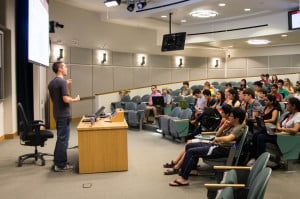
Beginning this year, Stanford’s popular introductory computer science (CS) courses, CS 106A: Programming Methodology and CS 106B: Programming Abstractions in C++, required interested students to apply before being able to join for the summer quarter.
According to Mehran Sahami ’92 M.S. ’93 Ph.D. ’99, professor of computer science and associate chair of education for the CS department, the application was necessary due to summer staffing shortages in section leaders, the hired undergraduate and graduate students who have typically taken the introductory courses themselves.
The section leading program
During the regular school year, students in CS 198: Teaching Computer Science act as section leaders for the CS 106 classes. According to Eric Yurko ’13 M.S. ’14, past CS 198 coordinator, although the numbers vary from quarter to quarter, on average there were roughly 100 section leaders and course helpers for the 900 CS 106 students each quarter in the 2013-14 academic year.
However, this summer, the courses have only 16 section leaders to accommodate the 194 students who were allowed to enroll in the summer classes after applications were reviewed.
Section leaders work closely with the enrolled students by teaching small weekly discussion sections that students must attend in addition to lectures. Section leaders also grade homework assignments and exams and provide help hours outside of lectures and discussions.
According to CS 106A section leader Rishi Bedi ’17, section leaders generally have fewer than 12 students each. During quarters with high enrollment, more staff members are necessary because of the large lectures, which can include hundreds of students.
“That’s been historically one of the problems in the summer,” Bedi said. “There are a ton of students who sign up during the summer, but there are not enough section leaders around.”
Last summer, high enrollment in the courses made it difficult for section leaders to teach students. Computer science lecturer and CS 106B instructor Marty Stepp explained that section leaders felt that the grading burden was overwhelming.
“We also had a few [section leaders] we had to desperately hire [and] who were working with us remotely,” Stepp said.
The need for staff last summer resulted in some section leaders using services like Skype or Google Hangout to communicate with students rather than teaching in-person.
“The quality of the service we were able to provide students just simply wasn’t adequate,” Stepp said. “Because of that, this summer, our section leader coordinating staff felt strongly that we could not allow the summer enrollment to exceed the amount that we would be able to serve adequately.”
Stepp also explained that section leaders typically leave campus for industry internships during the summer.
“All of our section leaders are talented, intelligent computer scientists [who] get great internships,” Stepp said. “They don’t really want to grade homework over the summer.”
The application process
The University requested that seats for both courses be divided into set numbers for students from each of the three major groups who take computer science classes at Stanford, explained Stepp. The groups include typical Stanford graduate and undergraduate students, high school students and people from the software industry who want to refresh their memories or acquire new computer science skills.
Applications for each class were reviewed by the respective summer course instructors and asked applicants for their contact information, student information and a short response to why they wanted to take the course.
According to Stepp, access to the courses was decided almost entirely on a first-come, first-serve basis, using the submission date of the application. Approximately 20 of the students who applied to CS 106B were not accepted into the class.
Stepp also spoke about some of the difficulties with the application process. For example, students who registered for ENGR 70A/B, the cross-listed classes for CS 106A/B, did not have to fill out the application. The instructors ultimately decided it would be unfair to eject the students.
Furthermore, some students who could not take the courses during the regular school year had to be turned down from enrolling during the summer. In the past, students have never been prevented from taking introductory CS classes at Stanford.As a result, future applications will also ask about students’ background knowledge and schedules rather than relying solely on the submission dates, said Stepp.
“It’s been tough for me as an instructor because I hate to turn students away,” Stepp said. “I would really like every single student who’s interested to have a seat in the class … But we felt this was a better outcome than admitting more people and providing them a poorer quality of instruction.”
Seeing the difference
The final summer enrollment numbers for CS 106A and B were 128 and 66, respectively.
In certain areas of the course, the difference in size is clear. For example, helper hours in the Tresidder LaIR are less busy in the summer with the enrollment cap than during larger quarters, said Bedi.
“[The enrollment cap] is certainly important in that we don’t want to have more students than we can appropriately staff,” Bedi said. “Keeping those section sizes small really makes a difference to the program.”
The application process will not apply to the introductory CS course during the academic year, although it may be reinstated again next summer, according to Stanford computer science lecturer Cynthia Lee, who is currently co-teaching the summer session of CS 106B with Stepp.
“This was a summer contingency plan,” Stepp said. “And depending on how things go this summer and throughout the rest of the year, it’s possible we’ll need to do something like this a year from now, but it’s not some sort of plan that we expect to have any effect on the fall, winter or spring [quarters].”
Contact Michelle Leung at michelle ‘dot’ leung ‘at’ saratogafalcon ‘dot’ org.
In a previous version of the article, the enrollment of the introductory CS classes was underestimated. The Daily regrets this error.
